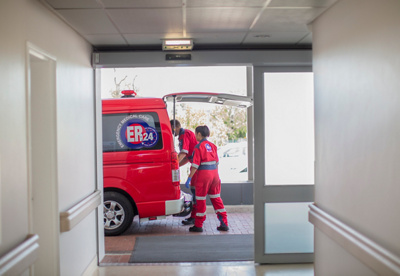That sense of being in the right place at the right time is one we've all experienced at some point in our lives.
This is a story of how, exactly a year ago, such a moment played a crucial role in the trajectory of saving the life of motorcyclist Chris Jurgens.
"I left for work later than normal," recalls Ryan Wills, Training Manager at Mediclinic Southern Africa. "Little did I know that Chris, too, had departed later than usual on his trip to work. As I came over the hill on the R44 heading towards Stellenbosch, I noticed something in the road, someone lying there. Upon stopping, my initial impression was that from the way he was lying, he was dead.”
Ryan, who is also an Emergency Care Practitioner (ECP), doesn't find himself responding to emergency calls as often nowadays. However, as he describes it, "coincidentally, I happened to have the necessary equipment in my vehicle that day."
“Despite the crucial protection offered by his helmet and neck brace, I could see that his injuries were severe and that he sustained a significant brain injury. At that moment, I just knew I had a role to play in saving his life. I knew I had to activate the chain of events that gave him the best chance of survival. I activated our local emergency medical services network, including ER24 advanced life support resources”.
Ryan provided advanced life support interventions at the scene, which included safely removing his helmet, managing his airway, establishing intravenous access, administering oxygen, and stabilising him until the arrival of ER24 paramedics. “Once the ER24 paramedics had arrived, a fellow ECP and I performed rapid sequence intubation (RSI) to insert a breathing tube and place Chris on a ventilator. This ensured the injuries sustained to his head, face, and chest would not impact his airway and breathing.”
He was transported to Mediclinic Vergelegen as the next step in his journey to recovery. True collaboration across the continuum of care is essential for the most positive outcomes.
Six weeks later, Chris, a lecturer at Stellenbosch University, emerged from a coma.
“I woke up at night. It was dark outside, and I realised I was in a hospital. All I could remember at the point was that I was on my way to work this morning, and now I seem to be in a hospital.”
His injuries were extensive – a fractured skull, bleeding on the brain, torn knee ligaments, a broken left shoulder, and a shattered right wrist.
“I was in ICU for a week, about a month in another ward and then a step-down facility. It was a very traumatic ordeal for my family. I initially only recognised my wife; I could not remember my two children or their names. It took about another month for my memories of them to return.”
As Chris embarked on his path to healing, he compiled a list of seven people he credits with saving his life. Ryan being one of them.

Chris busy with physiotherapy while in the step-down facility.

Chris ‘meeting’ his daughter again.
“I believe it was an absolute miracle,” Chris reflects. “It was a horrible ordeal, but as soon as Ryan stopped at the scene, I believe that set the course for my survival.”
In a heartfelt gesture of gratitude, Chris reached out to Ryan for a meeting over coffee.
“Meeting Chris and witnessing his remarkable recovery was an immensely gratifying experience. Though my current role is a little more deskbound, you never lose your ability to help or your inherent passion to save lives.”
Ryan provides the following information should you come across the scene of a collision:
- Prioritise your own safety above all else. If no emergency vehicles are present, pull over to a secure and unobstructed area.
- Dial ER24 on 084 124 and provide essential details: the location of the incident and an approximate indication of the number of injured individuals.
- Refrain from moving injured patients unless they are in imminent danger. Movement could exacerbate existing injuries such as fractures or internal trauma. If children are present, ensure they are under supervision and provided with reassurance. Unless compelled to seek assistance, remain at the scene until law enforcement or emergency responders instruct otherwise.


